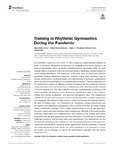Mostrar o rexistro simple do ítem
Training in Rhythmic Gymnastics during the pandemic
| dc.contributor.author | Bobo-Arce, Marta | |
| dc.contributor.author | Sierra Palmeiro, Elena | |
| dc.contributor.author | Fernández-Villarino, María A. | |
| dc.contributor.author | Fink, Hardy | |
| dc.date.accessioned | 2021-05-20T16:13:31Z | |
| dc.date.available | 2021-05-20T16:13:31Z | |
| dc.date.issued | 2021-04-09 | |
| dc.identifier.citation | Bobo-Arce M, Sierra-Palmeiro E, Fernández-Villarino MA and Fink H (2021) Training in Rhythmic Gymnastics During the Pandemic. Front. Psychol. 12:658872. doi: 10.3389/fpsyg.2021.658872 | es_ES |
| dc.identifier.issn | 1664-1078 | |
| dc.identifier.uri | http://hdl.handle.net/2183/27962 | |
| dc.description.abstract | [Abstract]: The pandemic caused by the COVID 19 Virus creates an unprecedented situation of global confinement altering the development of competition and sports training at all levels of participation and in all sports, including rhythmic gymnastics (RG). To avoid possible effects of physical, technical and psychological detraining, coaches looked for home training alternatives. The objectives of the study were to know how rhythmic gymnastics training developed during the lockdown period (the conditions, type of training, performance monitoring means, and determinants of gymnasts’ participation) and to provide recommendations for a possible future lockdown. Three hundred and two RG coaches from twenty-six different countries throughout the five continents and four professional levels took part in the study: national team (28), international (26), national (172) and regional (75). The data collection tool was a questionnaire consisting of 39 closed questions structured in three dimensions: identification data of the coaches, training data during confinement and gymnast participation data. The independent variable was the gymnasts’ performance levels and the dependent variables organized in four categories: the technical media used to conduct and monitor the training sessions, the type of training done, the mechanisms for monitoring training performance and the aspects that determined participation. Most coaches kept their gymnasts training during confinement, although 76.5% confirm abandonment of any of their gymnasts. The main means used were real-time video conferencing, although at the lower practice levels the media stand out in deferred time. The contents of the training were mainly body technique, physical preparation and body difficulties. For performance monitoring, challenges, physical, and technical tests were predominant. The determinants for the development of training in the confinement vary depending on the level of the gymnasts, connectivity and electronic resources at the highest level, and the availability of spaces and social distancing at lower levels. For future lockdowns, it is necessary to review the content of the trainings, as well as the performance evaluation and the means necessary for it. | es_ES |
| dc.language.iso | eng | es_ES |
| dc.publisher | Maneiro Dios, Rubén | es_ES |
| dc.relation.uri | https://www.frontiersin.org/articles/10.3389/fpsyg.2021.658872/full | es_ES |
| dc.rights | Atribución 3.0 España | es_ES |
| dc.rights.uri | http://creativecommons.org/licenses/by/3.0/es/ | * |
| dc.subject | COVID-19 | es_ES |
| dc.subject | Confinement | es_ES |
| dc.subject | Coaches | es_ES |
| dc.subject | Training | es_ES |
| dc.subject | Gymnasts | es_ES |
| dc.subject | Rhythic gymnastics | es_ES |
| dc.subject | Confinamento | es_ES |
| dc.subject | Adestradores | es_ES |
| dc.subject | Adestramento | es_ES |
| dc.subject | Ximnastas | es_ES |
| dc.subject | Ximnasia rítmica | es_ES |
| dc.subject | Confinamiento | es_ES |
| dc.subject | Entrenadores | es_ES |
| dc.subject | Entrenamiento | es_ES |
| dc.subject | Gimnastas | es_ES |
| dc.subject | Gimnasia rítmica | es_ES |
| dc.title | Training in Rhythmic Gymnastics during the pandemic | es_ES |
| dc.type | info:eu-repo/semantics/article | es_ES |
| dc.rights.access | info:eu-repo/semantics/openAccess | es_ES |
| UDC.journalTitle | Frontiers in Psychology | es_ES |
| UDC.volume | 12 | es_ES |
Ficheiros no ítem
Este ítem aparece na(s) seguinte(s) colección(s)
-
GI-ESAFEX - Artigos [32]






